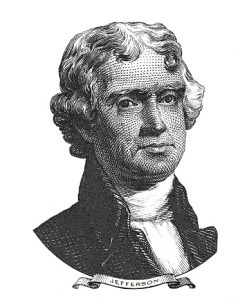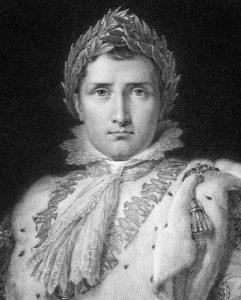In 1800, all the land held by the new United States was about the same as what was then called Louisiana. Louisiana was named for King Louis XIV of France. It was part of a large claimed area in the New World called New France. It stretched from the Great Lakes to the Gulf of Mexico and from the Appalachian Mountains to the Rocky Mountains.
France to America: Let's Make a Deal
Napoleon Bonaparte - famous French political leader, general, and eventually emperor - needed money to finance his wars of conquest in Europe so he decided to sell the whole thing to the young United States. President Thomas Jefferson wasn’t sure the deal was something the Constitution allowed, but he felt that the port of New Orleans was so important that he did not want it to be controlled by France or by Spain, the other big colonial powers.
Jefferson paid out $11,250,000 to Napoleon and also forgave France $3,750,000 in debt the country owed the United States. So, for $15 million the U.S. gained control of territory that doubled its size.
From 1804 to 1806, Americans Meriwether Lewis and William Clark went on a mission of exploration at President Jefferson’s request. They were sent to discover what Thomas Jefferson had bought with $15 million of the young country’s money.
*Land West of the Continental Divide Not Included
Even though the Louisiana Purchase was large, it did not extend the United States from sea to shining sea. Spain still controlled the land west of the Rocky Mountains until 1810 when Mexico declared its independence, electing its first president in 1824. But much of the northern Mexican territory would become part of the United States of America after the Mexican-American War in 1848 (the Mexican Cession).
The states that would eventually be created from the Louisiana Purchase include: Arkansas, Missouri, Iowa, Oklahoma, Kansas, Nebraska, parts of Minnesota that were west of the Mississippi River, most of North Dakota, nearly all of South Dakota, northeastern New Mexico, the portions of Montana, Wyoming, and Colorado east of the Continental Divide, and Louisiana west of the Mississippi River, including the city of New Orleans.
Books to Check Out
The Jeffersonian Republicans, 1800-1823
Discusses the events and personalities that shaped this country, from the hotly contested election of 1800 which brought Thomas Jefferson into office through the westward expansion to the War of 1812 and James Madison's presidency. (93 pages)
Lewis and Clark set out in 1804 to explore President Jefferson’s new purchase and find a Northwest Passage. (48 pages)
Looks at the political and economic history of the region between the Mississippi River and the Rocky Mountains which, when purchased by Jefferson in 1803, doubled the size of the United States and led the way to further expansion. (48 pages)
Explains the events that led Napoleon Bonaparte to sell the Louisiana Territory and the difficulties that Thomas Jefferson had in making the purchase that doubled the size of the United States. (48 pages)
A basic discussion about the history of the Louisiana Purchase, and how the United States expanded their lands by buying the Louisiana Territory from France
“This entertaining saga brings to life the intense negotiations between Napoleon and Jefferson over this legendary land deal. Art from the period, maps, a timeline, endnotes, a bibliography, and index give young readers all the resources they need to understand the period in which the Purchase took place.” (Publisher’s description)
On the Web
Our Documents: The Louisiana Purchase Treaty (1803)
Has summaries of the treaty and related documents, transcripts and images of the documents themselves.
Thomas Jefferson's Monticello: The Louisiana Purchase
Part of a well-written section on "Jefferson and Lewis and Clark." Other sections talk about the significance of the Lewis & Clark Expedition. It also includes a timeline.
U.S. History: Westward Expansion: The Louisiana Purchase
The essay portion is nicely and plainly written, and there are also links to pertinent sites, including information on tribes that would be displaced and the Louisiana State Museum.



